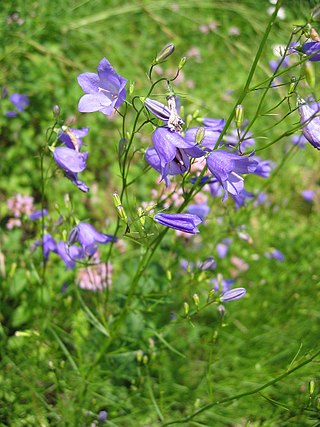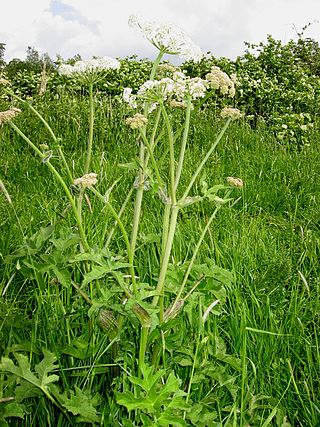
Nymphaeaceae is a family of flowering plants, commonly called water lilies. They live as rhizomatous aquatic herbs in temperate and tropical climates around the world. The family contains five genera with about 70 known species. Water lilies are rooted in soil in bodies of water, with leaves and flowers floating on or rising from the surface. Leaves are oval and heart-shaped in Barclaya. Leaves are round, with a radial notch in Nymphaea and Nuphar, but fully circular in Victoria and Euryale.

Lotus, a latinization of Greek lōtos, is a genus of flowering plants that includes most bird's-foot trefoils and deervetches. Depending on the taxonomic authority, roughly between 70 and 150 species are accepted, all legumes; American species formerly placed in the genus have been transferred to other genera. Lotus species are found in the Eastern Hemisphere and adapted to a wide range of habitats.

Lotus corniculatus is a flowering plant in the pea family Fabaceae. Common names include common bird's-foot trefoil, eggs and bacon, birdsfoot deervetch, and just bird's-foot trefoil. It has a wide distribution and is a favored forage for livestock.

Campanula rotundifolia, the common harebell, Scottish bluebell, or bluebell of Scotland, is a species of flowering plant in the bellflower family Campanulaceae. This herbaceous perennial is found throughout the temperate regions of the northern hemisphere. In Scotland, it is often known simply as bluebell. It is the floral emblem of Sweden where it is known as small bluebell. It produces its violet-blue, bell-shaped flowers in late summer and autumn.

Allium canadense, the Canada onion, Canadian garlic, wild garlic, meadow garlic and wild onion is a perennial plant native to eastern North America from Texas to Florida to New Brunswick to Montana. The species is also cultivated in other regions as an ornamental and as a garden culinary herb. The plant is also reportedly naturalized in Cuba.

Heracleum sphondylium, commonly known as hogweed or common hogweed, is a herbaceous perennial plant in the carrot family Apiaceae, which includes fennel, cow parsley, ground elder and giant hogweed. It is native to most of Europe, western Asia and northern Africa, but is introduced in North America and elsewhere. Other common names include cow parsnip. The flowers provide a great deal of nectar for pollinators.

Echium pininana, commonly known as the tree echium, pine echium, giant viper's-bugloss, or tower of jewels, is a species of flowering plant in the borage family Boraginaceae. It is endemic to the Canary Islands, where it is restricted to the island of La Palma. Echium pininana is an endangered species, and is listed in Appendix I to, and is therefore protected under, the Convention on the Conservation of European Wildlife and Natural Habitats. The specific epithet pininana is Latin for "small pine", though E. pininana is neither closely related to the pine, nor does it resemble that plant.

Persicaria hydropiperoides, commonly called swamp smartweed, mild waterpepper, false waterpepper, or sometimes simply waterpepper, is a species of flowering plant in the buckwheat family. It has a widespread distribution across much of North America and South America. Its preferred habitat is in moist, saturated to inundated soils growing in full sun to partial shade; such as swamp forests, marshes, streams, shorelines, and ditches. It is sometimes semi-aquatic.

Romulea columnae, the sand crocus, is a herbaceous perennial in the family Iridaceae. It is a small plant, with thin narrow leaves, and small scape which has small pink, pale purple or violet pointed flowers with darker veining and a gold or yellow throat. It is native to a wide area ranging from western Europe to the Mediterranean.
Lotus discolor is a plant in the genus Lotus.
Lotus laricus is a plant native to Iran, Oman, Pakistan in the genus Lotus. It is an upright perennial to a trailing annual.
Lotus assakensis is a plant from the Lotus genus native from Morocco to Mauritania.
Lotus dumetorum is a plant in the genus Lotus endemic to the Canary Islands.
Lotus glacialis is a perennial plant in the genus Lotus native to S. Spain.
Lotus goetzei is a plant in the genus Lotus ranging from Ethiopia to S.southern Tropical Africa.

Lotus holosericeus is a plant in the genus Lotus endemic to the Canary Islands.
Lotus krylovii is a plant in the genus Lotus ranging from SE Ukraine to Mongolia and Pakistan.
Lotus lancerottensis is a species of plant in the Lotus genus native to southern Madeira and the Canary Islands.
Lotus lebrunii is species in the genus Lotus endemic to the DR Congo.









